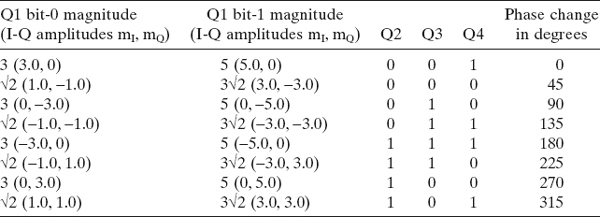14.10 V.29 MODEM
The V.29 modem operates in duplex and half-duplex mode. It can operate at data rates of 9600, 7200, and 4800 bits per second (bps). It uses 16-QAM for data rates of 9600 bps, 8-QAM for 7200 bps, and 4-PSK for 4800 bps. V.27ter has 4800-bps PSK support. To avoid duplicity, the 4800-bps mode of V.29 is supported from V.27ter. Data transmissions with V.29 and signal details are listed below [ITU-T-V.29 (1988), URL (SPRA073)]:
Baud rate and modulation: 2400 symbols, 16-QAM for 9600 bps, 8-QAM for 7200 bps, and 4-PSK for 4800 bps
Center frequency: 1700 ± 1 Hz, and no separate pilot tones are used
Power levels: Power output should not exceed 1 mW, and nominal level −13 dBm as per V.2
Signal detection: Signal is detected if signal level is greater than −26 dBm
QAM at 9600 bps. To get a 9600 fax rate with 2400 symbols per second, it is required to send 4 bits on each symbol as one group. A group of four consecutive data bits is called quadbits. The first bit (Q1) in time of each quadbit is used to determine the amplitude of the carrier to be transmitted. The second (Q2), third (Q3), and fourth (Q4) bits are used to encode the phase shift. The relative amplitude of the transmitted signal element is determined by the first bit (Q1) of the quadbit and the absolute phase of the signal element as shown in Table 14.4.
Table 14.4. Phase and Relative Amplitude at 9600 bps

Table ...
Get VoIP Voice and Fax Signal Processing now with the O’Reilly learning platform.
O’Reilly members experience books, live events, courses curated by job role, and more from O’Reilly and nearly 200 top publishers.

